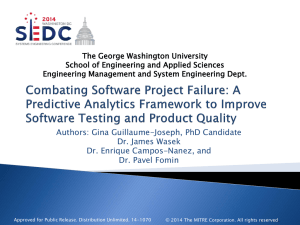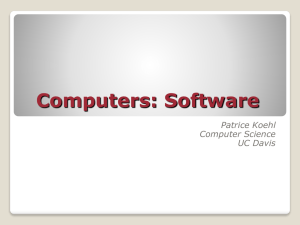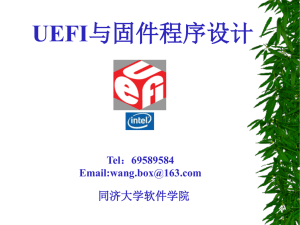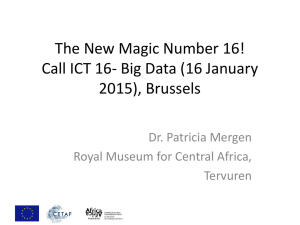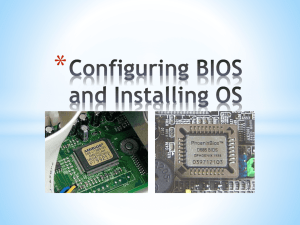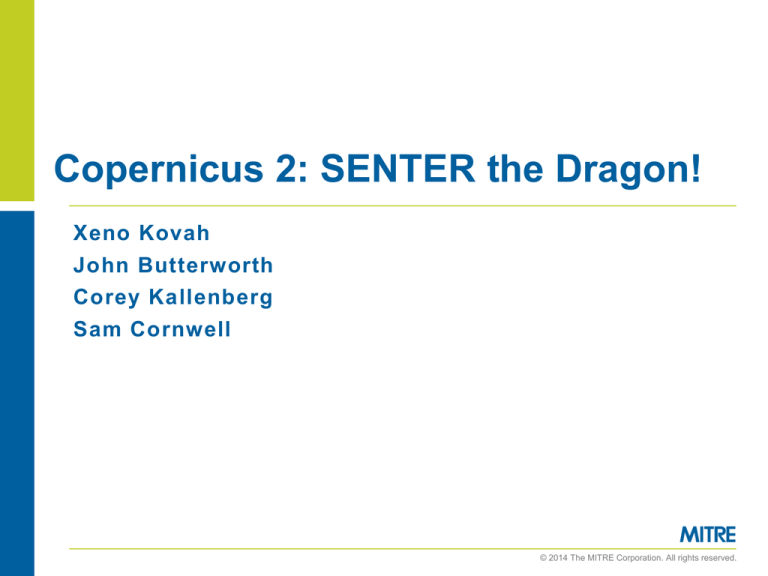
Copernicus 2: SENTER the Dragon!
Xeno Kovah
John Butterworth
Corey Kallenberg
Sam Cornwell
© 2014 The MITRE Corporation. All rights reserved.
|2|
Background
In 2013 we presented BIOS Chronomancy[18] which is built into
the BIOS/SMM to counter attackers at the same privilege level
We also presented two PoC BIOS attackers, a tick, and a flea
that defeated the existing Trusted Computing Group "static core
root of trust for measurement" (S-CRTM) system which tries to
provide a trusted boot.
© 2014 The MITRE Corporation. All rights reserved.
|3|
Tick Demo Video
http://www.youtube.com/watch?v=S0lRcm3jvFo
The Tick from http://th04.deviantart.net/fs6/PRE/i/2005/087/1/b/The_Tick_by_emucoupons.png
|4|
The Flea
http://www.youtube.com/watch?v=fvQjhqzxHR8
All the same stealth capabilities of the Tick
Achieves persistence beyond BIOS re-flashes
– “Jumps” from one BIOS revision to another during updates
The Flea – Robert Hooke (aka Mixmaster Mike-roscope) – Micrographia – 1665
|5|
Copernicus
Hello strange (cyber)space-men of the
future.
Question your
assumptions!
There can be only one!
Who wins in a smackdown between BIOS
malware, and Copernicus?
The malware. Always.
We built Copernicus to be something “best effort” that could be
deployed quickly with minimal requirements, to try and catch
firmware malware with their pants down
– Where there was darkness, we said “let there be light!” ;)
– When we live in a world where no one is checking their firmware,
any firmware malware need not necessarily fear detection and
thus can be vulnerable to a surprise detect
– Just the act of existing costs attackers development time/money if
they hadn’t previously provided any self-protection
Now let’s see what we need to do to make Copernicus actually
trustworthy
© 2013 The MITRE Corporation. All rights reserved.
|6|
|7|
Attack 0 – DoS Copernicus
Prevent Copernicus from running
Possibly easily detected, but what are you going to do about it?
© 2013 The MITRE Corporation. All rights reserved.
|8|
Attack 1 – Manipulate Copernicus output
From within the OS, targeted hooks into Copernicus code
From within the OS with “DDefy” [20] rootkit style hooks into file
writing routines
From within the HD controller firmware [21][22][23]
From within the OS with a network packet filter driver
From within the NIC firmware [24][25]
Etc. Lots more options
© 2013 The MITRE Corporation. All rights reserved.
Attack 2 – A new generic attack.
• It is possible for SMM to be notified when SPI reads or writes occur
• An attacker who controls the BIOS controls the setup of SMM
• In this way a BIOS-infecting attacker can perform a SMM MitM
attack against those who would try to read the BIOS to integrity
check it
• We call our SMM MitM “Smite’em, the Stealthy”
© 2013 The MITRE Corporation. All rights
reserved.
http://www.creativeuncut.com/g
allery-11/gw2-dragon-eye.html
| 10 |
Smite’em: Engineering a dragon
Smite’em is a PoC attack that can MitM reads to the SPI Flash
– Thus it can conceal its presence even from applications that dump
the SPI flash
– Like MITRE Copernicus, Flashrom (and all the people like
Raytheon Pikeworks, Selective Intellect, AFRL, etc who just throw
Flashrom at the problem), Intel ChipSec, McAfee DeepDefender…
But hey, at least people are starting to make detectors…
Multiple ways to design it
– Interrupt-driven – FSMIE bit
– Polling – SCIP/FDONE bit
– VMX-based
| 11 |
SPI (Serial Peripheral Interface) Flash
Intel provides a
programmable interface to
the SPI flash device
– System BIOS lives here
– Other stuff does too
Copernicus programs this
interface to dump a binary
of the SPI flash
Intel IO Controller Hub 10 Datasheet, page 31
| 12 |
Programming the SPI Flash
SPI Host Interface registers are memory-mapped at an offset in
the RCRB (Root Complex Register Block)
An app can choose either Hardware Sequencing or Software
Sequencing
– For simplicity of discussion, we’ll be referring to only those
operations/details pertaining to Hardware Sequencing
Software Sequencing just offers a little more fine-grain control
All SPI registers in the following slides are from:
http://www.intel.com/content/www/us/en/io/io-controller-hub-10-family-datasheet.html
| 13 |
SPI Programming Flash Address Register
Specifies starting address of the SPI I/O cycle
– Flash address, not a system RAM address
– Valid range is 0 to <size of flash chip – 1>
| 14 |
SPI Programming Data Registers
Contains the data read from the SPI flash (up to 64 bytes)
R/W (since it can be used to specify data to write to flash)
Smite’em overwrites this data from within SMM
…
| 15 |
SPI Programming Control Register
Initiates the SPI I/O cycle
– Used by programming app (Copernicus)
Defines the number of bits to read (or write) in the I/O cycle
| 16 |
SPI Programming Status Register
Indicates that an SPI I/O cycle is in progress
Set automatically by hardware
| 17 |
SPI Programming Status Register 2
Indicates the SPI I/O cycle has completed
Smite’em polls this bit to ensure the SPI I/O cycle has completed
before forging the data in the FDATA registers
| 18 |
Eye of the dragon - FSMIE - hw sequencing
This is what allows an attacker in SMM to know when someone
is trying to access the flash chip
The Flash Cycle Done bit is set to 1 after every read and write
© 2013 The MITRE Corporation. All rights reserved.
| 19 |
Eye of the dragon - FSMIE - sw sequencing
And here’s the bit that gives the same functionality if someone
is using software sequencing to access flash
© 2013 The MITRE Corporation. All rights reserved.
| 20 |
Reading the flash chip in the presence of
Smite'em
SMM
Smite'em
FADDR=00000…
FDATA0=00000…
Ring 0
FDONE=0
SCIP=0
FCYCLE=0
FGO=0
FSMIE=1
BIOS reading software sets up the location it wants to read (as
part of reading the entire chip) and how many bytes to read
© 2013 The MITRE Corporation. All rights reserved.
| 21 |
Reading the flash chip in the presence of
Smite'em
SMM
Smite'em
FADDR=0x1000
FDATA0=00000…
Ring 0
FDONE=0
SCIP=0
FCYCLE=0
FGO=0
FSMIE=1
BIOS reading software says to start the read
© 2013 The MITRE Corporation. All rights reserved.
| 22 |
Reading the flash chip in the presence of
Smite'em
SMM
Smite'em
FADDR=0x1000
FDATA0=00000…
Ring 0
FDONE=0
SCIP=1
FCYCLE=0
FGO=1
FSMIE=1
Cycle in progress
© 2013 The MITRE Corporation. All rights reserved.
| 23 |
Reading the flash chip in the presence of
Smite'em
SMM
SMI
Smite'em
FADDR=0x1000
FDATA0=0x1badd00d
Ring 0
FDONE=1
SCIP=0
FCYCLE=0
FGO=0
FSMIE=1
Once the cycle is done, and the data is available for reading, if
the FSMIE = 1, an SMI is triggered, giving Smite'em the first look
© 2013 The MITRE Corporation. All rights reserved.
| 24 |
Reading the flash chip in the presence of
Smite'em
SMM
Smite'em
FADDR=0x1000
FDATA0=0x1badd00d
Ring 0
FDONE=1
SCIP=0
FCYCLE=0
FGO=0
FSMIE=1
Smite'em can change any data that would reveal its presence to
the original benign data
© 2013 The MITRE Corporation. All rights reserved.
| 25 |
Reading the flash chip in the presence of
Smite'em
SMM
Smite'em
FADDR=0x1000
FDATA0=0xf005ba11
Ring 0
FDONE=1
SCIP=0
FCYCLE=0
FGO=0
FSMIE=1
BIOS reading software will be mislead
© 2013 The MITRE Corporation. All rights reserved.
| 26 |
Think it can't happen?
Flashrom 0.9.7 source
If you don't account for hw/sw sequencing's FSMIE bit (as no
previous software did), you will just lose and provide false
assurances of a lack of BIOS compromise
© 2014 The MITRE Corporation. All rights reserved.
| 27 |
What you don't know can bite you
The basic solution would seem to be just for querying tools to
set FSMIE = 0 before trying to read
Multiple ways for an adversary to counter
– Kernel agent continuously setting FSMIE = 1
So you just clear it and check if it's getting re-set, and if so…?
– VMX interception of MMIO to SPI space, falsifying that you
successfully cleared FSMIE
But then if they're using VMX too, they can also just directly forge
FDATA
– Target your security software specifically
If your tool is good enough to detect attacker, he's incentivized to go
after you specifically
© 2013 The MITRE Corporation. All rights reserved.
| 28 |
Terror at 35,000 feet (high level overview)
Another attack…
Let's assume that Smite'em wants to pick another generic, low
effort way to avoid detection (i.e. doesn't want to use VMX until
absolutely necessary)
Smite'em recruits a Dragon Knight avatar
– Could be kernel-based code or a DMA device and independent of
CPU
Avatar polls SPI configuration registers to detect if an SPI cycle
is in progress
Upon detecting an SPI cycle in progress, the avatar triggers an
SMI
Smite’em running in SMM has exclusive access to the CPU, and
can stall until the cycle completes and then replace the data
read from flash before Copernicus can read it
| 29 |
Reading the flash chip in the presence of
Smite'em
SMM
Smite'em
FADDR=00000…
FDATA0=00000…
Ring 0
FDONE=0
SCIP=0
FCYCLE=0
FGO=0
FSMIE=0
Copernicus sets up the location it wants to read (as part of
reading the entire chip) and how many bytes to read
© 2013 The MITRE Corporation. All rights reserved.
| 30 |
Reading the flash chip in the presence of
Smite'em
SMM
Smite'em
FADDR=0x1000
FDATA0=00000…
Ring 0
FDONE=0
SCIP=0
FCYCLE=0
FGO=0
FSMIE=0
Then says go
© 2013 The MITRE Corporation. All rights reserved.
| 31 |
Reading the flash chip in the presence of
Smite'em
SMM
Smite'em
FADDR=0x1000
FDATA0=00000…
Ring 0
FDONE=0
SCIP=1
FCYCLE=0
FGO=1
FSMIE=0
Copernicus sets up the location it wants to read (as part of
reading the entire chip) and how many
© 2013 The MITRE Corporation. All rights reserved.
| 32 |
Reading the flash chip in the presence of
Smite'em
SMM
Smite'em
SMI
Ring 0
FADDR=0x1000
FDATA0=0x1badd00d
FDONE=1
SCIP=0
FCYCLE=0
FGO=0
FSMIE=0
Once it sees the data, it tries not to race with Copernicus, but
instead stops itself and Copernicus by signaling Smite'em with
an SMI
© 2013 The MITRE Corporation. All rights reserved.
| 33 |
Reading the flash chip in the presence of
Smite'em
SMM
Smite'em
FADDR=0x1000
FDATA0=0x1badd00d
Ring 0
FDONE=1
SCIP=0
FCYCLE=0
FGO=0
FSMIE=0
Smite'em then cleans up as usual
© 2013 The MITRE Corporation. All rights reserved.
| 34 |
Demo video
http://youtu.be/NfwNRKFghxE
© 2014 The MITRE Corporation. All rights reserved.
Smite'em vs. Copernicus 2
| 36 |
How can we defeat Smite’em?
We could utilize our Checkmate[19] timing-based attestation
system within our Copernicus kernel driver, and incorporate SMI
disabling or FSMIE disabling into the self-check as a new
“untampered execution environment” check
But we saw an opportunity to take a more direct path, and
simultaneously get smart on some other trusted computing tech
Smite'em lives in SMM, let's disable SMIs
But its not sufficient to just disable them from an OS driver,
because an attacker could just nop out our code to do so
A side effect of Intel TXT is that it disables SMIs
– "The ILP must re-enable SMIs which were disabled as part of the
SENTER process"
So lets learn about Intel Trusted Execution Technology (TXT)
– Called “Safer Mode Extensions” (SMX) in the Intel manuals
© 2013 The MITRE Corporation. All rights reserved.
| 37 |
© 2013 The MITRE Corporation. All rights reserved.
| 38 |
Intel Trusted Execution Technology (TXT)
Dynamic Root of Trust for Measurement
A means to provide "late launch" trust
– You had a presumed-compromised system, you start TXT, and
you're left in a state you setup and that you can trust
© 2013 The MITRE Corporation. All rights reserved.
From http://invisiblethingslab.com/resources/bh09dc/Attacking%20Intel%20TXT%20-%20slides.pdf| 39 |
© 2013 The MITRE Corporation. All rights reserved.
| 40 |
How does it work?
New Intel instruction “GETSEC”
It’s sort of like CPUID in that it’s a single instruction that does
different things based on what the value is in the EAX register at
the time that it’s called
EAX = 0; GETSEC[CAPABILITIES] = report the capabilities
EAX = 1; GETSEC[ENTERACCS] = run authenticated code (AC)
EAX = 2; GETSEC[EXITAC] = stop running AC
EAX = 3; GETSEC[SENTER] = Start a Measured Launch
Environment (MLE) – this is the main one we care about, and the
source of the title of this talk
EAX = 4; GETSEC[SEXIT] = exit MLE
EAX = 5; GETSEC[PARAMETERS] = reports supported AC info
EAX = 6; GETSEC[SMCTRL] = turn on SMIs
EAX = 7; GETSEC[WAKEUP] = wake up sleeping processors
© 2013 The MITRE Corporation. All rights reserved.
| 41 |
We’re only interested in a subset
We have to use GETSEC[CAPABILITIES] and
GETSEC[PARAMETERS] just for sanity checking purposes
We mainly care about SENTER and SEXIT to start and stop our
MLE
We’re *NOT* going to use SMCTRL or WAKEUP
– The whole point here is to freeze SMM code in place
© 2013 The MITRE Corporation. All rights reserved.
| 42 |
But…what about ITL’s attacks on TXT?!?!
“I thought they broke TXT six ways from Sunday?!?!”
“Doesn’t this mean no one can ever trust TXT for anything ever
again?!”
No
It just means you need to utilize TXT with awareness of the attacks
Lets review their TXT-relevant attacks
© 2013 The MITRE Corporation. All rights reserved.
| 43 |
Feb. 2009 - Attacking Intel Trusted Execution
Technology – Wojtczuk & Rutkowska [5]
Had an at-the-time-undisclosed vulnerability to get into SMM
Found that SMRAM is not measured as part of the MLE launch
Once defender gets into their MLE, they’re encouraged to issue
GETSEC[SMCTRL] to enable SMIs as soon as possible
– Recall that SMM will often handle performance-critical things like
motherboard fan control, so ideally you don’t want to go leaving it
off for a long time
Therefore once SMIs are enabled, and the first one is fired, the
attacker regains control, within the context of the MLE
– They can then potentially subvert a hypervisor/OS that’s being
launched with tboot
© 2013 The MITRE Corporation. All rights reserved.
| 44 |
Does [5] directly affect us?
No
We’re already using TXT under the assumption that we’re
dealing with compromised SMM
Therefore our MLE doesn’t reenable SMIs until we’re done with
everything security-critical
– This is only an option for us since we're just popping up into TXT
land and then back out as soon as we check a few things
© 2013 The MITRE Corporation. All rights reserved.
| 45 |
Dec. 2009 - Another Way to Circumvent Intel®
Trusted Execution Technology – Wojtczuk,
Rutkowska, Tereshkin [6]
One of the jobs of the SINIT modules is to sanity check that the
MLE's memory is protected from DMA attacks
However there was a bug where it read a 64 bit field as 32 bits
The 64 bit address was what was actually protected, and the
attacker just had to make sure the bottom 32 bits were the same
as the MLE 32 bits, and the sanity check would pass
© 2013 The MITRE Corporation. All rights reserved.
| 46 |
Does [6] directly affect us?
No
Intel released patched SINIT modules for all their chipsets
We use the latest patched one
But also because we don't use the VT-d protection, we use the
TXT special "DMA Protected Region", which as Intel says is
– This is only an option for us because we're loading a small amount
of code. If we were trying to launch/protect a hypervisor, we would
have to use VT-d
© 2013 The MITRE Corporation. All rights reserved.
Dec. 2011 - Exploring new lands on Intel
CPUs (SINIT code execution hijacking) Wojtczuk & Rutkowska [7]
| 47 |
A critical component of TXT is the use of the ACMs.
The ACM which is used during an SENTER is the SINIT ACM
binary blob that you have to map into memory and give the base
address to SENTER in register EBX
SINIT sanity checks that the environment is correctly setup and
conducive to
But at the end of the day it’s still just signed x86 code!
x86 code that does parsing!
x86 code that does parsing that ITL found a buffer overflow in!
:O
© 2013 The MITRE Corporation. All rights reserved.
Dec. 2011 - Exploring new lands on Intel
CPUs (SINIT code execution hijacking) Wojtczuk & Rutkowska [7]
The last, and arguably the best, of all of ITL’s attacks ever
The buffer overflow occurs when SINIT is parsing the DMA
Remapping (DMAR) ACPI (Advanced Configuration and Power
Interface) table, which is set up by BIOS
– In this way there is an unfortunate dependancy of the DRTM on
the SRTM
– We’ve shown the flawed nature of current SRTMs in our BIOS
Chronomancy work [18]
© 2013 The MITRE Corporation. All rights reserved.
| 48 |
| 49 |
Does [7] affect us?
No
Intel released patched SINIT modules for all their chipsets. We
use the latest patched one
BUT…
© 2013 The MITRE Corporation. All rights reserved.
| 50 |
Purging the sin in SINIT
All we can do is pray there are no more bugs in the SINIT code
– Or evaluate it ourselves… but Intel says that's not allowed in the
EULA…"yay trusted computing" :-/
– An SINIT module is maybe around 5k instructions based on its
size. Hopefully there won’t be *that* many more errors ;)
Compare this to our timing-based[18][19] code's root of trust, which is
about 60 instructions per block, 8 variant blocks, and open source
Obviously just hoping that there are no more bugs and the
attacker can’t get in is anathema to our stated goal with our
timing-based attestation work, that we want to assume the
attacker is at the same privilege level as us
But we’ll go with it for now as a risk we have no choice but to
accept in order to play with this technology
© 2013 The MITRE Corporation. All rights reserved.
| 51 |
SENTER THE DRAGON!
© 2013 The MITRE Corporation. All rights reserved.
| 52 |
Copernicus 1 Architecture
RAM/Physical Address Space
BIOS Alias (high mem)
CPU
Cache
High
SMRAM
PCH
SPI Flash Chip
Copernicus.sys
UEFI BIOS Firmware
Low
© 2013 The MITRE Corporation. All rights reserved.
| 53 |
Copernicus 1 Architecture
RAM/Physical Address Space
BIOS Alias (high mem)
CPU
Cache
High
SMRAM
PCH
SPI Flash Chip
Copernicus.sys
UEFI BIOS Firmware
Low
© 2013 The MITRE Corporation. All rights reserved.
| 54 |
Copernicus 1 Architecture
RAM/Physical Address Space
BIOS Alias (high mem)
CPU
Cache
High
SMRAM
PCH
SPI Flash Chip
Copernicus.sys
UEFI BIOS Firmware
Low
© 2013 The MITRE Corporation. All rights reserved.
| 55 |
Smite’em Attacks!
RAM/Physical Address Space
BIOS Alias (high mem)
CPU
Cache
High
SMRAM
PCH
SPI Flash Chip
Copernicus.sys
UEFI BIOS Firmware
Low
© 2013 The MITRE Corporation. All rights reserved.
| 56 |
Copernicus 2 Architecture
RAM/Physical Address Space
BIOS Alias (high mem)
CPU
Cache
High
SMRAM
TXT Heap
PCH
SINIT Area
Measured Launch Environment (MLE)
SPI Flash Chip
Copernicus2.sys
UEFI BIOS Firmware
Low
© 2013 The MITRE Corporation. All rights reserved.
| 57 |
Overall behavior 1
Initial actions:
– Turn on TPM & TXT
– Provision TPM key for later signature verification
– Load Flicker driver, pass MLE code to Flicker, tell it to start
© 2013 The MITRE Corporation. All rights reserved.
| 58 |
Copernicus 2 Architecture
RAM/Physical Address Space
BIOS Alias (high mem)
CPU
Cache
High
SMRAM
TXT Heap
PCH
SINIT ACM
copied
SINIT
Area from disk
Measured Launch Environment (MLE)
SPI
Flash Chip
UEFI BIOS
Firmware
LPC
TPM
PCR0 = 0xfa7e…
…
PCR17 = 0x0000
PCR18 = 0x0000
© 2013 The MITRE Corporation. All rights reserved.
Copernicus2.sys
FlickerDrv.sys
Low
| 59 |
Copernicus 2 Architecture
RAM/Physical Address Space
BIOS Alias (high mem)
CPU
Cache
High
SMRAM
TXT Heap
PCH
SINIT ACM
copied
SINIT
Area from disk
Measured
Launch
(MLE)
Construct
MLE Environment
& paging structs
SPI
Flash Chip
UEFI BIOS
Firmware
LPC
TPM
PCR0 = 0xfa7e…
…
PCR17 = 0x0000
PCR18 = 0x0000
© 2013 The MITRE Corporation. All rights reserved.
Copernicus2.sys
FlickerDrv.sys
Low
| 60 |
Copernicus 2 Architecture
RAM/Physical Address Space
BIOS Alias (high mem)
CPU
Cache
High
SMRAM
Setup TXT
TXT heap
Heap structs
PCH
SINIT ACM
copied
SINIT
Area from disk
Measured
Launch
Environment
MLE
& paging
structs (MLE)
SPI
Flash Chip
UEFI BIOS
Firmware
LPC
TPM
PCR0 = 0xfa7e…
…
PCR17 = 0x0000
PCR18 = 0x0000
© 2013 The MITRE Corporation. All rights reserved.
Copernicus2.sys
FlickerDrv.sys
Low
| 61 |
Copernicus 2 Architecture
RAM/Physical Address Space
BIOS Alias (high mem)
CPU
Cache
High
SMRAM
Heap
TXTTXT
heap
structs
SENTER!
SINIT ACM copied from disk
PCH
SINIT Area
Measured
Launch
Environment
MLE
& paging
structs (MLE)
SPI
Flash Chip
UEFI BIOS
Firmware
LPC
TPM
PCR0 = 0xfa7e…
…
PCR17 = 0x0000
PCR18 = 0x0000
© 2013 The MITRE Corporation. All rights reserved.
Copernicus2.sys
FlickerDrv.sys
Low
| 62 |
Copernicus 2 Architecture
RAM/Physical Address Space
BIOS Alias (high mem)
CPU
Cache
High
SMRAM
Heap
TXTTXT
heap
structs
PCH
SINIT ACM
copied
SINIT
Area from disk
Measured
Launch
Environment
MLE
& paging
structs (MLE)
SPI
Flash Chip
UEFI BIOS
Firmware
LPC
TPM
PCR0 = 0xfa7e…
…
PCR17 = 0x0000
PCR18 = 0x0000
© 2013 The MITRE Corporation. All rights reserved.
Copernicus2.sys
FlickerDrv.sys
Low
| 63 |
Copernicus 2 Architecture
RAM/Physical Address Space
BIOS Alias (high mem)
CPU
SINIT ACM copied
from disk
Cache
High
SMRAM
Heap
TXTTXT
heap
structs
PCH
SINIT ACM
copied
SINIT
Area from disk
Measured
Launch
Environment
MLE
& paging
structs (MLE)
SPI
Flash Chip
UEFI BIOS
Firmware
LPC
TPM
PCR0 = 0xfa7e…
…
PCR17 = 0x0000
PCR18 = 0x0000
© 2013 The MITRE Corporation. All rights reserved.
Copernicus2.sys
FlickerDrv.sys
Low
| 64 |
Copernicus 2 Architecture
RAM/Physical Address Space
BIOS Alias (high mem)
CPU
SINIT ACM copied
from disk
Cache
High
SMRAM
Heap
TXTTXT
heap
structs
PCH
SPI
Flash Chip
UEFI BIOS
Firmware
S
t
o
LPC
r
e TPM
PCR0 = 0xfa7e…
…
PCR17 = 0x0000
PCR18 = 0x0000
© 2013 The MITRE Corporation. All rights reserved.
SINIT ACM
copied
SINIT
Area from disk
Measured
Launch
Environment
MLE
& paging
structs (MLE)
Copernicus2.sys
FlickerDrv.sys
Low
| 65 |
Copernicus 2 Architecture
RAM/Physical Address Space
BIOS Alias (high mem)
CPU
SINIT ACM copied
from disk
Cache
High
SMRAM
Heap
TXTTXT
heap
structs
PCH
SPI
Flash Chip
UEFI BIOS
Firmware
S
t
o
LPC
r
e TPM
PCR0 = 0xfa7e…
…
PCR17 = 0x136b
PCR18 = 0x0000
© 2013 The MITRE Corporation. All rights reserved.
SINIT ACM
copied
SINIT
Area from disk
Measured
Launch
Environment
MLE
& paging
structs (MLE)
Copernicus2.sys
FlickerDrv.sys
Low
| 66 |
Copernicus 2 Architecture
RAM/Physical Address Space
BIOS Alias (high mem)
CPU
SINIT ACM copied
from disk
Cache
High
SMRAM
Heap
TXTTXT
heap
structs
PCH
SPI
Flash Chip
UEFI BIOS
Firmware
S
t
o
LPC
r
TPM
e
PCR0 = 0xfa7e…
…
PCR17 = 0x136b
PCR18 = 0x0000
© 2013 The MITRE Corporation. All rights reserved.
SINIT ACM
copied
SINIT
Area from disk
Measured
Launch
Environment
MLE
& paging
structs (MLE)
Copernicus2.sys
FlickerDrv.sys
Low
| 67 |
Copernicus 2 Architecture
RAM/Physical Address Space
BIOS Alias (high mem)
CPU
SINIT ACM copied
from disk
Cache
High
SMRAM
Heap
TXTTXT
heap
structs
PCH
SINIT ACM
copied
SINIT
Area from disk
Measured
Launch
Environment
MLE
& paging
structs (MLE)
SPI
Flash Chip
UEFI BIOS
Firmware
LPC
TPM
PCR0 = 0xfa7e…
…
PCR17 = 0x136b
PCR18 = 0xac02
© 2013 The MITRE Corporation. All rights reserved.
Copernicus2.sys
FlickerDrv.sys
Low
| 68 |
Overall behavior 2
MLE actions:
– Read config info, place text in buffer, SHA1 hash it, extend buffer
into TPM Platform Configuration Register (PCR) 18
– Read BIOS 0x10000 at a time, SHA1 hash it, extend buffer into
PCR 18
– SEXIT
© 2013 The MITRE Corporation. All rights reserved.
| 69 |
Copernicus 2 Architecture
RAM/Physical Address Space
BIOS Alias (high mem)
CPU
SINIT ACM copied
from disk
Cache
High
SMRAM
Heap
TXTTXT
heap
structs
PCH
SINIT ACM
copied
SINIT
Area from disk
Measured
Launch
Environment
MLE
& paging
structs (MLE)
SPI
Flash Chip
UEFI BIOS
Firmware
LPC
TPM
PCR0 = 0xfa7e…
…
PCR17 = 0x136b
PCR18 = 0xac02
© 2013 The MITRE Corporation. All rights reserved.
Copernicus2.sys
FlickerDrv.sys
Low
| 70 |
Copernicus 2 Architecture
RAM/Physical Address Space
BIOS Alias (high mem)
CPU
SINIT ACM copied
from disk
Cache
High
SMRAM
Heap
TXTTXT
heap
structs
PCH
SINIT ACM
copied
SINIT
Area from disk
Measured
Launch
Environment
MLE
& paging
structs (MLE)
SPI
Flash Chip
UEFI BIOS
Firmware
LPC
TPM
PCR0 = 0xfa7e…
…
PCR17 = 0x136b
PCR18 = 0xac02
© 2013 The MITRE Corporation. All rights reserved.
Copernicus2.sys
FlickerDrv.sys
Low
| 71 |
Copernicus 2 Architecture
RAM/Physical Address Space
BIOS Alias (high mem)
CPU
SINIT ACM copied
from disk
Cache
High
SMRAM
Heap
TXTTXT
heap
structs
PCH
SINIT ACM
copied
SINIT
Area from disk
Measured
Launch
Environment
MLE
& paging
structs (MLE)
SPI
Flash Chip
UEFI BIOS
Firmware
LPC
TPM
PCR0 = 0xfa7e…
…
PCR17 = 0x136b
PCR18 = 0xf005
© 2013 The MITRE Corporation. All rights reserved.
Copernicus2.sys
FlickerDrv.sys
Low
| 72 |
Copernicus 2 Architecture
RAM/Physical Address Space
BIOS Alias (high mem)
CPU
SINIT ACM copied
from disk
Cache
High
SMRAM
Heap
TXTTXT
heap
structs
PCH
SINIT ACM
copied
SINIT
Area from disk
Measured
Launch
Environment
MLE
& paging
structs (MLE)
SPI
Flash Chip
UEFI BIOS
Firmware
LPC
TPM
PCR0 = 0xfa7e…
…
PCR17 = 0x136b
PCR18 = 0xf005
© 2013 The MITRE Corporation. All rights reserved.
Copernicus2.sys
FlickerDrv.sys
Low
| 73 |
Copernicus 2 Architecture
RAM/Physical Address Space
BIOS Alias (high mem)
CPU
SINIT ACM copied
from disk
Cache
High
SMRAM
Heap
TXTTXT
heap
structs
PCH
SINIT ACM
copied
SINIT
Area from disk
Measured
Launch
Environment
MLE
& paging
structs (MLE)
SPI
Flash Chip
UEFI BIOS
Firmware
LPC
TPM
PCR0 = 0xfa7e…
…
PCR17 = 0x136b
PCR18 = 0xf005
© 2013 The MITRE Corporation. All rights reserved.
Copernicus2.sys
FlickerDrv.sys
Low
| 74 |
Copernicus 2 Architecture
RAM/Physical Address Space
BIOS Alias (high mem)
CPU
SINIT ACM copied
from disk
Cache
High
SMRAM
Heap
TXTTXT
heap
structs
PCH
SINIT ACM
copied
SINIT
Area from disk
Measured
Launch
Environment
MLE
& paging
structs (MLE)
SPI
Flash Chip
UEFI BIOS
Firmware
LPC
TPM
PCR0 = 0xfa7e…
…
PCR17 = 0x136b
PCR18 = 0xba11
© 2013 The MITRE Corporation. All rights reserved.
Copernicus2.sys
FlickerDrv.sys
Low
| 75 |
Copernicus 2 Architecture
RAM/Physical Address Space
BIOS Alias (high mem)
CPU
SINIT ACM copied
from disk
Cache
High
SMRAM
Heap
TXTTXT
heap
structs
SEXITSINIT ACM copied from disk
PCH
SINIT Area
Measured
Launch
Environment
MLE
& paging
structs (MLE)
SPI
Flash Chip
UEFI BIOS
Firmware
LPC
TPM
PCR0 = 0xfa7e…
…
PCR17 = 0x136b
PCR18 = 0xba11
© 2013 The MITRE Corporation. All rights reserved.
Copernicus2.sys
FlickerDrv.sys
Low
| 76 |
Copernicus 2 Architecture
RAM/Physical Address Space
High
BIOS Alias (high mem)
CPU
SINIT ACM copied
from disk
Cache
SMRAM
Heap
TXTTXT
heap
structs
PCH
SINIT ACM
copied
SINIT
Area from disk
Measured
Launch
Environment
MLE
& paging
structs (MLE)
SPI
Flash Chip
UEFI BIOS
Firmware
LPC
TPM
PCR0 = 0xfa7e…
…
PCR17 = 0x136b
PCR18 = 0xba11
© 2013 The MITRE Corporation. All rights reserved.
Copernicus2.sys
Start
FlickerDrv.sys
Low
| 77 |
Overall behavior 3
Actions upon resume:
– Perform equivalent config and BIOS reads from copernicus2.sys,
write to disk. Also dump TXT heap for reconstructing PCRs
– Get TPM Quote of PCR 17, 18, 19, verify signature, write to disk
© 2013 The MITRE Corporation. All rights reserved.
| 78 |
Copernicus 2 Architecture
RAM/Physical Address Space
BIOS Alias (high mem)
CPU
SINIT ACM copied
from disk
Cache
High
SMRAM
Heap
TXTTXT
heap
structs
PCH
SINIT ACM
copied
SINIT
Area from disk
Measured
Launch
Environment
MLE
& paging
structs (MLE)
SPI
Flash Chip
UEFI BIOS
Firmware
LPC
TPM
PCR0 = 0xfa7e…
Copernicus2.sys
…
PCR17 = 0x136b
PCR18 = 0xba11
© 2013 The MITRE Corporation. All rights reserved.
Low
| 79 |
Copernicus 2 Architecture
RAM/Physical Address Space
BIOS Alias (high mem)
CPU
SINIT ACM copied
from disk
Cache
High
SMRAM
Heap
TXTTXT
heap
structs
PCH
SINIT ACM
copied
SINIT
Area from disk
Measured
Launch
Environment
MLE
& paging
structs (MLE)
SPI
Flash Chip
UEFI BIOS
Firmware
LPC
TPM
PCR0 = 0xfa7e…
Copernicus2.sys
…
PCR17 = 0x136b
PCR18 = 0xba11
© 2013 The MITRE Corporation. All rights reserved.
Low
| 80 |
Verifying measurements
Validate signature on TPM PCR 17 & 18 Quote
Confirm PCR17 is derived from the fields and values given in the
“PCR 17” section (1.9.1.1 in the June 2013 TXT sw dev guide)
Confirm PCR18 ==
SHA1(SHA1((SHA1(020 | MleHash) | SHA1(config)) | SHA1(BIOS))
– Can slightly differ depending on the TXT version, e.g. it could actually
be using SHA256 in the MleHash
We don't need to actually write the data to disk from within the MLE.
We just need to collect it and hash it into the TPM PCRs
– This is good for cross-OS support, and for performance, that we're not
sitting in the MLE with SMIs disabled for extra time
(Note: verification should generally be done on some other
presumed-trusted platform, such as a server that has no purpose
other than verification. “If you try to evaluate the trust on the
potentially compromised system you’re going to have a bad time”)
© 2013 The MITRE Corporation. All rights reserved.
| 81 |
Done!
Fun on a bun, right?
As for the extra steps and effort included by making Copernicus
2 "Trusted"…This is the whole reason we chose to release
Copernicus 1 as a "best effort" system to start with.
Trusted Computing is HARD yo!
– Put another way, anyone who's not going to this level of effort is
probably feeding you bogus results
"Other evaluators of TXT have made the same comment, 'Oh,
this is complex.' The first question back to them has been, 'what
should we remove?' The answer has always been 'I do not see
anything you can remove.'"
– David Grawrock, Intel, "Dynamics of a Trusted Computing System:
A Building Blocks Approach", Chapter 11
© 2013 The MITRE Corporation. All rights reserved.
| 82 |
If everything matches
Congrats, you have a genuine measurement…
Now you just need to figure out whether it actually contains
malice or not ;)
John has started offering a BIOS analysis class to help people
understand what a reported difference in a BIOS actually means
– Too bad you missed it at CSW
– In the meantime you’ve probably got a lot of background material
you should freshen up on, e.g. paging, port IO, static RE, IDA, etc
– Better head over to http://OpenSecurityTraining.info
© 2013 The MITRE Corporation. All rights reserved.
| 83 |
Conclusions
There exists the potential for an attacker who controls SMM to
perform a Man in the Middle attack on SPI reads and writes
We have implemented such an attack
– Smite’em the Stealthy
The Great Hero Copernicus subsequently went into the belly of
the beast and slew it with the power of TXT.
Anyone giving you a BIOS measurement and *not* using TXT is
untrustworthy
– “Copernicus 2 tech” – ask for it by name ;)
– We’re licensing it to companies doing firmware integrity checks
– We're releasing a binary-only version if you want to try it out:
– http://www.mitre.org/capabilities/cybersecurity/overview/cybersecur
ity-blog/playing-hide-and-seek-with-bios-implants
If you don’t have TXT support, or if your vendor messed up your
TXT support, you’re out of luck and you stay vulnerable!
– Smite’em’s children live on in low end (non-TXT) machines
© 2013 The MITRE Corporation. All rights reserved.
| 84 |
Demonstration time-permitting
Video here: http://youtu.be/4qRsTe0-_f8
© 2014 The MITRE Corporation. All rights reserved.
| 85 |
FAQ
I'm not running it until I can see the source code. How do I get
access to Cop 1 or 2 src?
– Cop 1 src is available free on a code-for-data basis to people who will
pilot it on thousands of machines. This helps our future research
– Cop 2 src is available for licensing
– Contact copernicus@mitre.org
If I don’t have TXT or can’t turn it on everywhere is there still any
value in non-trustworthy BIOS collection systems like Copernicus
1, flashrom, ChipSec, etc?
– Yes, attackers probably weren’t expecting them, and thus it may catch
ones who don’t (yet) implement Smite’em functionality
What about Vendor X? Can I trust their measurements?
– Probably not. We’re talking with some vendors about incorporation,
but none of them have done it yet.
© 2013 The MITRE Corporation. All rights reserved.
| 86 |
Thanks, Contacts, Questions?
Thanks to Rafal Wojtchzuk for his excellent feedback and for
pointing out an easy attack we overlooked.
Thanks to Jon McCune and the team from CMU for making
Flicker for people to build on.
– Our changes we contributed back to make it work with default Win
7 32 with PAE enabled are here:
– http://sourceforge.net/p/flickertcb/code/ci/experimental-pae-support
xkovah, jbutterworth, callenberg, scornwell @ mitre.org
@xenokovah, @jwbutterworth3, @coreykal
© 2014 The MITRE Corporation. All rights reserved.
| 87 |
References
[1] Attacking Intel BIOS – Alexander Tereshkin & Rafal Wojtczuk – Jul. 2009
http://invisiblethingslab.com/resources/bh09usa/Attacking%20Intel%20BIOS.pdf
[2] TPM PC Client Specification - Feb. 2013
http://www.trustedcomputinggroup.org/developers/pc_client/specifications/
[3] Evil Maid Just Got Angrier: Why Full-Disk Encryption With TPM is Insecure
on Many Systems – Yuriy Bulygin – Mar. 2013
http://cansecwest.com/slides/2013/Evil%20Maid%20Just%20Got%20Angrier.pdf
[4] A Tale of One Software Bypass of Windows 8 Secure Boot – Yuriy Bulygin –
Jul. 2013 http://blackhat.com/us-13/briefings.html#Bulygin
[5] Attacking Intel Trusted Execution Technology - Rafal Wojtczuk and Joanna
Rutkowska – Feb. 2009
http://invisiblethingslab.com/resources/bh09dc/Attacking%20Intel%20TXT%20%20paper.pdf
[6] Another Way to Circumvent Intel® Trusted Execution Technology - Rafal
Wojtczuk, Joanna Rutkowska, and Alexander Tereshkin – Dec. 2009
http://invisiblethingslab.com/resources/misc09/Another%20TXT%20Attack.pdf
[7] Exploring new lands on Intel CPUs (SINIT code execution hijacking) - Rafal
Wojtczuk and Joanna Rutkowska – Dec. 2011
http://www.invisiblethingslab.com/resources/2011/Attacking_Intel_TXT_via_SINI
T_hijacking.pdf
[7] Meet 'Rakshasa,' The Malware Infection Designed To Be Undetectable And
Incurable - http://www.forbes.com/sites/andygreenberg/2012/07/26/meetrakshasa-the-malware-infection-designed-to-be-undetectable-and-incurable/
| 88 |
References 2
[8] Implementing and Detecting an ACPI BIOS Rootkit – Heasman, Feb.
2006 http://www.blackhat.com/presentations/bh-europe-06/bh-eu-06Heasman.pdf
[9] Implementing and Detecting a PCI Rookit – Heasman, Feb. 2007
http://www.blackhat.com/presentations/bh-dc-07/Heasman/Paper/bhdc-07-Heasman-WP.pdf
[10] Using CPU System Management Mode to Circumvent Operating
System Security Functions - Duflot et al., Mar. 2006
http://www.ssi.gouv.fr/archive/fr/sciences/fichiers/lti/cansecwest2006duflot-paper.pdf
[11] Getting into the SMRAM:SMM Reloaded – Duflot et. Al, Mar. 2009
http://cansecwest.com/csw09/csw09-duflot.pdf
[12] Attacking SMM Memory via Intel® CPU Cache Poisoning –
Wojtczuk & Rutkowska, Mar. 2009
http://invisiblethingslab.com/resources/misc09/smm_cache_fun.pdf
[13] Defeating Signed BIOS Enforcement – Kallenberg et al., Sept. 2013
– URL not yet available, email us for slides
[14] Mebromi: The first BIOS rootkit in the wild – Giuliani, Sept. 2011
http://www.webroot.com/blog/2011/09/13/mebromi-the-first-biosrootkit-in-the-wild/
| 89 |
References 3
[15] Persistent BIOS Infection – Sacco & Ortega, Mar. 2009
http://cansecwest.com/csw09/csw09-sacco-ortega.pdf
[16] Deactivate the Rootkit – Ortega & Sacco, Jul. 2009
http://www.blackhat.com/presentations/bh-usa09/ORTEGA/BHUSA09-Ortega-DeactivateRootkit-PAPER.pdf
[17] Sticky Fingers & KBC Custom Shop – Gazet, Jun. 2011
http://esec-lab.sogeti.com/dotclear/public/publications/11-reconstickyfingers_slides.pdf
[18] BIOS Chronomancy: Fixing the Core Root of Trust for
Measurement – Butterworth et al., May 2013
http://www.nosuchcon.org/talks/D2_01_Butterworth_BIOS_Chrono
mancy.pdf
[19] New Results for Timing-based Attestation – Kovah et al., May
2012 http://www.ieee-security.org/TC/SP2012/papers/4681a239.pdf
http://www.blackhat.com/presentations/bh-jp-06/BH-JP-06-Bilbyup.pdf
| 90 |
References 4
[20] Low Down and Dirty: Anti-forensic Rootkits - Darren Bilby,
Oct.2006 http://www.blackhat.com/presentations/bh-jp-06/BH-JP-06Bilby-up.pdf
[21] Implementation and Implications of a Stealth Hard-Drive Backdoor
– Zaddach et al., Dec. 2013 https://www.ibr.cs.tubs.de/users/kurmus/papers/acsac13.pdf
[22] Hard Disk Hacking – Sprite, Jul.
2013http://spritesmods.com/?art=hddhack
[23] Embedded Devices Security and Firmware Reverse Engineering Zaddach & Costin, Jul. 2013 https://media.blackhat.com/us-13/US-13Zaddach-Workshop-on-Embedded-Devices-Security-and-FirmwareReverse-Engineering-WP.pdf
[24] Can You Still Trust Your Network Card – Duflot et al., Mar. 2010
http://www.ssi.gouv.fr/IMG/pdf/csw-trustnetworkcard.pdf
[25] Project Maux Mk.II, Arrigo Triulzi, Mar. 2008
http://www.alchemistowl.org/arrigo/Papers/Arrigo-Triulzi-PACSEC08Project-Maux-II.pdf
| 91 |
Backup
I likes the nitty gritty, but decided this is too much of a side-track
from the main point of the talk
Also I wrote this up in the ideal way it's implemented, but Flicker
differs slightly so I need to re-work to show how flicker does it
© 2014 The MITRE Corporation. All rights reserved.
| 92 |
TXT Configuration Registers
At fixed physical address 0xFED3000 + offset
Specified in Appendix B of the TXT developers guide
TXT.SINIT.BASE = offset 0x270 = physical memory address the
BIOS has set aside for the SINIT module to be copied into
TXT.SINIT.SIZE = offset 0x278 = maximum available memory
TXT.HEAP.BASE = offset 0x300 = physical memory reserved for
use by the MLE, but also used when bootstrapping the MLE
TXT.HEAP.SIZE = offset 0x308 = maximum available memory
TXT.DPR = offset 0x330 = definition for the DMA Protected
Region. This is actually a separate sort of DMA protection that
doesn’t have anything to do with Intel VT-d (IOMMU)
Also has some error status and other important registers which
we won’t cover right now
© 2013 The MITRE Corporation. All rights reserved.
Example reading TXT config regs with
“Read Write Everything” – link
From a HP Elitebook 2540p
TXT.SINIT.BASE
TXT.SINIT.SIZE
TXT.HEAP.BASE
TXT.HEAP.SIZE
TXT.DPR
DPR
Interpretation
(from Intel TXT
sw dev guide)
© 2013 The MITRE Corporation. All rights reserved.
TXT.DPR.Top = 0xBB800000
| 93 |
Copernicus 2 Architecture: Enhance!
RAM/Physical Address Space
High
BIOS Alias (high mem)
TXT.DPR.Top
SMRAM
0xBB800000
DPR
also TSEG base
TXT Heap
0xBB720000
Required
SINIT Area
0xBB700000
DPR
Extra
MLE Area (for our implementation)
DMA Protected
Region
(DPR)
0xBB400000
Copernicus2.sys
DPR base =
TXT.DPR.Top –
(TXT.DPR.Size*0x100000)
Low
© 2013 The MITRE Corporation. All rights reserved.
Copernicus 2 Architecture: Enhance!
RAM/Physical Address Space
High
BIOS Alias (high mem)
SMRAM
TXT Heap
SINIT Area
TXT.SINIT.SIZE
Actual SINIT copy
DPR
TXT.SINIT.BASE
Copernicus2.sys
Low
© 2013 The MITRE Corporation. All rights reserved.
Copernicus 2 Architecture: Enhance!
RAM/Physical Address Space
High
BIOS Alias (high mem)
SMRAM
TXT Heap BIOS data, OS to MLE, OS to SINIT, SINIT to MLE structs
TXT.HEAP.SIZE
SINIT Area (see TXT dev guide Appendix C for struct defs)
TXT.HEAP.BASE
DPR
Copernicus2.sys
Low
© 2013 The MITRE Corporation. All rights reserved.
Copernicus 2 Architecture: Enhance!
RAM/Physical Address Space
High
BIOS Alias (high mem)
TXT.DPR.Top
SMRAM
TXT Heap
SINIT Area
DPR
MLE Code
MLE Helper Struct
MLE PAE Paging Structs
DPR base
Copernicus2.sys
Low
© 2013 The MITRE Corporation. All rights reserved.
Copernicus 2 Architecture: Enhance!
RAM/Physical Address Space
High
BIOS Alias (high mem)
TXT.DPR.Top
SMRAM
TXT Heap
SINIT Area
DPR
aka TSEG base
TXT.HEAP.SIZE
TXT.HEAP.BASE
TXT.SINIT.SIZE
TXT.SINIT.BASE
OS to SINIT and SINIT to MLE structs
Actual SINIT copy
MLE Code
MLE Helper Struct Info
MLE Page Tables
DPR base =
Copernicus2.sys
TXT.DPR.Top –
(TXT.DPR.Size*0x100000)
Low
© 2013 The MITRE Corporation. All rights reserved.
| 99 |
Copernicus 2 Architecture
RAM/Physical Address Space
BIOS Alias (high mem)
CPU
Cache
High
SMRAM
TXT Heap
PCH
SINIT Area
Measured Launch Environment (MLE)
SPI
Flash Chip
UEFI BIOS
Firmware
LPC
TPM
PCR0 = 0xfa7e…
Copernicus2.sys
…
PCR17 = 0x0000
PCR18 = 0x0000
© 2013 The MITRE Corporation. All rights reserved.
Low
| 100 |
Paging?
Yes, that’s right, you have to roll your own PAE (Physical
Address Extensions) paging structures in order to use TXT!
– Not canonical 32 bit paging that you learn in school, not 64 bit
paging, but PAE 36 bit paging
Kind of a tall order for most folks
– Part of why TXT has limited uptake
But on the plus side you can go out and learn about x86 paging
right now by taking Xeno’s free “Intermediate x86 class”
– http://OpenSecurityTraining.info/Intermediatex86.html
© 2013 The MITRE Corporation. All rights reserved.
100

